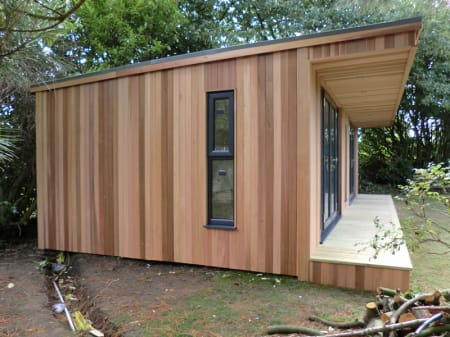Western Red Cedar External Cladding For Garden Rooms
Western red cedar external cladding (Thuja plicata) is produced from a species of conifer tree that is native to the western coast of North America.
It is a tall, evergreen tree that can grow up to 200 feet (60 meters) in height and can live for more than 1,000 years.
Western red cedar external cladding is known for its distinctive, reddish-brown bark and its flat, scale-like leaves that are arranged in a fan-like pattern.
It is a popular ornamental tree that is often used in landscaping and horticulture, and it is also valued for its wood, which is used in a variety of applications, including external timber cladding, fencing, roofing, and furniture.
Western red cedar external cladding (Thuja plicata) is a popular wood species for a variety of applications due to its natural resistance to decay and insects, as well as its ability to withstand harsh weather conditions. It is commonly used for outdoor projects such as external timber cladding and indoor projects such as flooring.
Western red cedar external cladding is also a popular choice for the construction of saunas and hot tubs due to its ability to retain heat and its natural resistance to moisture. In addition, western red cedar external cladding is known for its beautiful appearance, with a rich, reddish-brown colour and a fine, straight grain that gives it a smooth, even texture. It is a softwood that is relatively lightweight and easy to work with, making it a good choice for a variety of applications.
Western red cedar external cladding is most commonly used for outdoor cladding, particularly in residential garden rooms and garden buildings aswel as commercial construction. This wood is known for its durability, beauty, and resistance to decay and insects, making it a popular choice for exterior cladding, fencing, and other outdoor applications.
One of the primary benefits of using western red cedar external cladding is its natural resistance to decay and insects. The wood contains natural preservatives that help protect it from rot and decay, and it is also resistant to insect infestations. This means that it can withstand the elements and maintain its structural integrity for many years, even in harsh environments.
Another benefit of western red cedar external cladding is its natural beauty. The wood has a warm, reddish-brown colour that ages gracefully over time, and its grain patterns are distinctive and attractive. It is also a very stable wood, which means that it is less likely to warp or twist when exposed to the elements.
Western red cedar external cladding is also a sustainable and environmentally friendly choice for timber cladding. It is a renewable resource that is grown and harvested in a responsible and sustainable manner, and it has a low impact on the environment during its production and transportation. It is also a natural insulator, which means that it can help reduce energy costs by providing insulation to the building.
In addition to its durability, beauty, and sustainability, western red cedar external cladding is also relatively easy to maintain. It can be easily cleaned and maintained with regular washing and staining, and it does not require any special care or maintenance beyond this.
Overall, western red cedar external cladding is a high-quality, durable, and attractive choice for external cladding that offers many benefits to homeowners and builders. Its natural resistance to decay and insects, beautiful appearance, and sustainability make it a popular choice for a wide range of outdoor applications.
